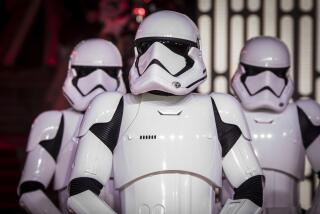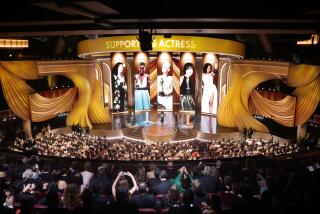‘Star Wars: The Force Awakens’ sound editors and mixers discuss crafting BB-8 and Kylo Ren’s voices
“Star Wars: The Force Awakens” may not have earned a best picture Oscar nomination, but the billion-dollar box-office record-setter did manage to nab five other nods, including two in sound — editing (Matthew Wood, David Acord) and mixing (Andy Nelson, Christopher Scarabosio, Stuart Wilson).
Equipped with two newly built Panavision cameras, dubbed “Millennium Falcon” and “Death Star,” director J.J. Abrams and crew found themselves battling 120-degree heat in the Abu Dhabi desert on the first day of principal photography. The remote location introduces us to planet Jakku, where Rey (Daisy Ridley) encounters the droid BB-8 and takes off on a journey to find the Resistance.
See more of Entertainment’s top stories on Facebook >>
For the actors to interact with BB-8, the sound team built a receiver and speaker system into five different set versions. “This allowed J.J. to trigger audio from a tablet or a live microphone depending on the situation,” Wilson says. In postproduction, Wood and Acord were tasked with developing BB-8’s original sound. “J.J. had a lot of interest in the voice of BB-8,” Wood says.
“He wanted it to sound distinct enough so if it was outside the doorway, and you couldn’t see it, you’d still know it was him. We set J.J. up with a tactical interface so he could be more hands-on in the creative process and have points to touch on a synthesizer, controlling timbre and pitch. We then brought actors in to guide an emotional beat and refined BB-8 until we found its final audio palette,” Wood says.
A similar approach was used for the voice of Kylo Ren (Adam Driver). On set, Wilson placed a microphone inside his mask and attached another one to his chest. “Adam has a great voice, and by placing two mics and combining them in phase, it gave it this larger-than-life quality with a lot of bass and presence.” Wood then recorded additional dialogue with Driver using the mask’s final post processing. “We don’t normally do that kind of thing live with an actor, but it allowed Adam to get more into the character and play with it as an acting tool.” It was then up to Nelson to make the dialogue audible. “There’s a tendency when you hear a line of dialogue a few times that it becomes clearer in your head even if the audience can’t. So I became the gatekeeper and stepped in when we needed to lighten up so the audience wouldn’t be left saying, ‘What did he say?’”
The team had to differentiate a number of audio cues, including Ren’s use of the Force. “Kylo is very raw with his power and not a very refined person,” Acord says. “He’s a little hot-tempered and we wanted to reflect that aurally. At the very root level of Ren’s Force we used the purr of a cat ... slowed way down to a low rumble.”
When Rey realizes she has powers of her own, the sound team based the characteristics on a beating heart. “When Kylo tries to use the Force on Rey and she starts to push back, I felt like her power came from within, so I created a calming sound that was similar to a rhythmic heart,” adds Acord.
“In the final mix, J.J. wanted the audience to feel something,” says Scarabosio. “With a note like that, we wanted to make sure we didn’t fatigue the audience over long periods of time. It was really a matter of being judicious with the sound and when to focus on the music, dialogue or effects.” One example of that is when the audience is introduced to Finn (John Boyega). “When we first see Finn we don’t know it’s him, just a Stormtrooper who’s realizing he doesn’t want to kill for the First Order. After he kneels down to console a dying Stormtrooper, you can still see all this action behind him. We wanted the audience to focus solely on Finn so we took the sound track down to just his breathing with music ... so the audience realizes there’s something special about this Stormtrooper even before he takes off his helmet.”
“‘Star Wars’ is messy,” Wood says. “Even back when we were working with George Lucas, he would always say, ‘It’s messy. It’s funky. It’s not perfect.’
“When it was crunch time you could really see J.J. focus in. He became fully engaged to a point that energized the entire crew and I think we came up with something the audience will find entertaining.”
More to Read
From the Oscars to the Emmys.
Get the Envelope newsletter for exclusive awards season coverage, behind-the-scenes stories from the Envelope podcast and columnist Glenn Whipp’s must-read analysis.
You may occasionally receive promotional content from the Los Angeles Times.








